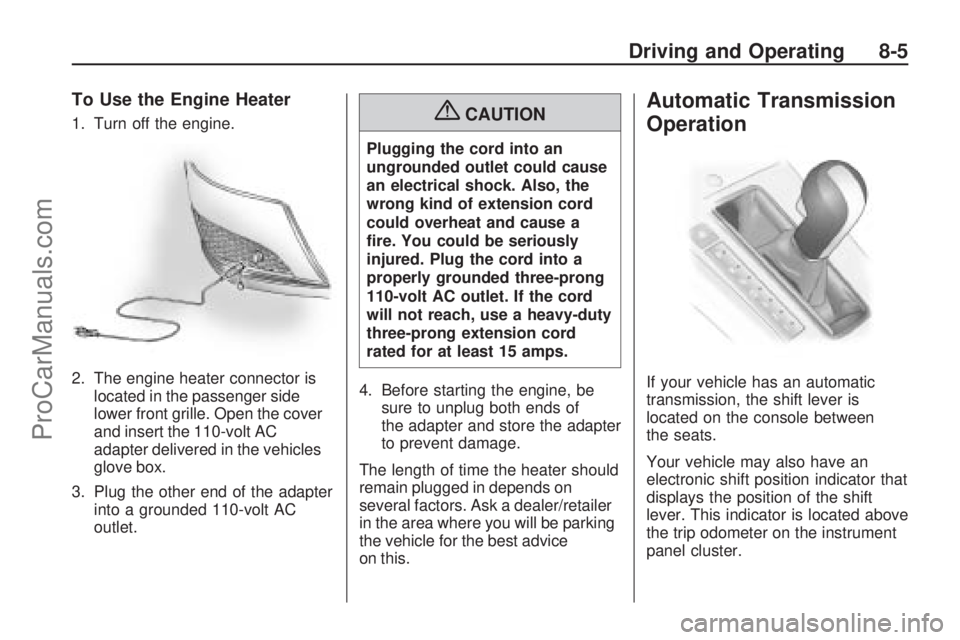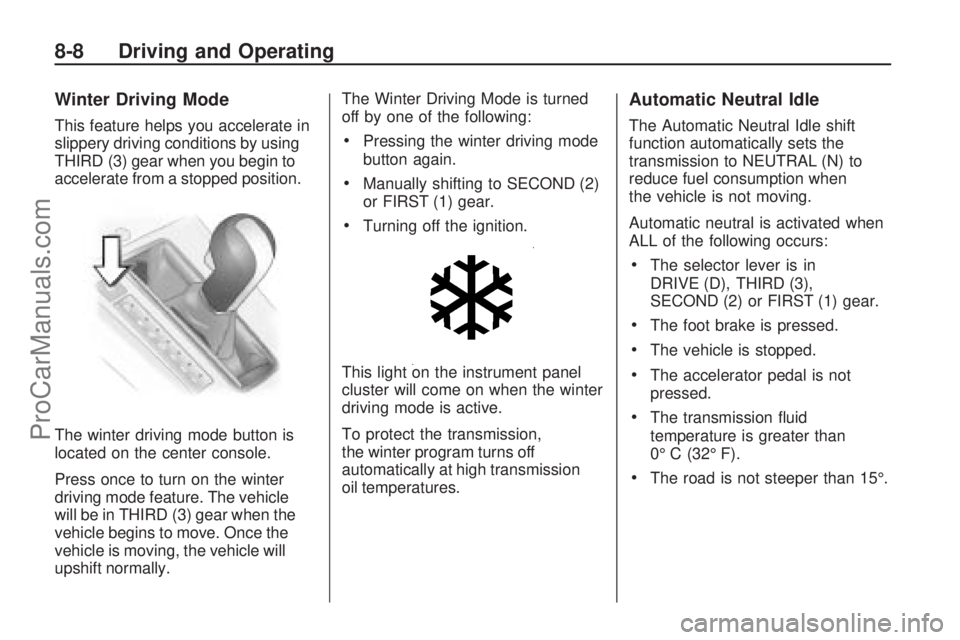instrument cluster SATURN ASTRA 2008 User Guide
[x] Cancel search | Manufacturer: SATURN, Model Year: 2008, Model line: ASTRA, Model: SATURN ASTRA 2008Pages: 304, PDF Size: 1.92 MB
Page 90 of 304

Safety Belt Reminders
Driver Safety Belt Reminder
Light
There is a Driver Safety Belt
Reminder Light on the instrument
panel cluster.
When the engine is started this light
and chime will come on and stay on
for several seconds to remind people
to fasten their safety belts. The light
will also begin to �ash.This cycle repeats if the driver
remains unbuckled and the vehicle
is moving.
If the driver’s belt is already buckled,
neither the light nor chime will
come on.
Passenger Safety Belt
Reminder Light
If your vehicle has this light, it will
operate the same as the Safety Belt
Reminder Light except that it is
meant for the front passenger.
If the passenger’s safety belt is
buckled, neither the chime nor the
light will come on.
Airbag Readiness Light
This light tells you if there is an
electrical problem. The system check
includes the airbag sensor, the
pretensioners, the airbag modules,
the wiring and the crash sensing
and diagnostic module. For more
information on the airbag system,
seeAirbag System on page 1-23.
This light will come on and stay
on for several seconds when you
start your vehicle. Then the light
should go out.
4-14 Instruments and Controls
ProCarManuals.com
Page 93 of 304

If, after several seconds, both status
indicator lights remain on, or if there
are no lights at all, there may be
a problem with the lights or the
passenger sensing system.
See your dealer/retailer for service.
{CAUTION
If the airbag readiness light in
the instrument panel cluster
ever comes on and stays on, it
means that something may be
wrong with the airbag system.
If this ever happens, have the
vehicle serviced promptly,
because an adult-size person
sitting in the right front
passenger’s seat may not have
the protection of the airbag(s).
SeeAirbag Readiness Light
on page 4-14for more on this,
including important safety
information.
Charging System Light
This light comes on brie�y when the
ignition is turned on, but the engine is
not running, as a check to show the
light is working. It should go out
when the engine is started.
If the light stays on, or comes
on while driving, there may be a
problem with the electrical charging
system. Have it checked by your
dealer/retailer. Driving while this
light is on could drain the battery.
If a short distance must be driven
with the light on, be sure to turn off
all accessories, such as the radio
and air conditioner.
Brake System Warning
Light
This light should come on brie�y
when the ignition is turned on.
If it does not come on, have it �xed
so it will be ready to warn you if
there is a problem.
When the ignition is on, the brake
system warning light will come on
when the parking brake is set.
The light will stay on if the parking
brake does not release fully. If it
stays on after the parking brake is
fully released, there is a brake
problem. Have your brake system
inspected immediately.
United StatesCanada
Instruments and Controls 4-17
ProCarManuals.com
Page 120 of 304

Daytime Running
Lamps (DRL)
Daytime Running Lamps (DRL) can
make it easier for others to see
the front of your vehicle during the
day. DRL can be helpful in many
different driving conditions, but they
can be especially helpful in the
short periods after dawn and before
sunset. Fully functional daytime
running lamps are required on all
vehicles �rst sold in Canada.
The DRL system makes the
low-beam headlamps turn on at
a reduced brightness when
the following conditions are met:
The engine is running.
The light sensor determines it
is night and the exterior lamps
control is in the off position.
The light sensor determines
it is daytime.The taillamps and other lamps will
be off.
The DRL turns off when the engine
is not running.
The regular headlamps or parking
lamps should be used when needed.
Delayed Headlamps
Vehicles with headlamp exit delay,
keep the headlamps and taillamps
on for 30 seconds.
To activate:
1. Turn the ignition off and remove
the key from the ignition.
2. Open the driver door.
3. Pull the multifunction lever
toward the steering wheel.
To deactivate, do either of the
following:
Insert the key into the ignition.
Pull the multifunction lever toward
the steering wheel again while
the driver door is open.
Fog Lamps
For vehicles with fog lamps, the
button is located on the instrument
panel, to the left of the steering
wheel.
The ignition and headlamps or
parking lamps must be on to turn on
the fog lamps. The fog lamps will not
turn on if the high beam headlamps
or �ash to pass are active.
Press the button to turn the fog
lamps on or off. An indicator light on
the instrument panel cluster comes
on when the fog lamps are on.
Some localities have laws that
require the headlamps to be
on along with the fog lamps.
5-2 Lighting
ProCarManuals.com
Page 157 of 304

To Use the Engine Heater
1. Turn off the engine.
2. The engine heater connector is
located in the passenger side
lower front grille. Open the cover
and insert the 110-volt AC
adapter delivered in the vehicles
glove box.
3. Plug the other end of the adapter
into a grounded 110-volt AC
outlet.{CAUTION
Plugging the cord into an
ungrounded outlet could cause
an electrical shock. Also, the
wrong kind of extension cord
could overheat and cause a
�re. You could be seriously
injured. Plug the cord into a
properly grounded three-prong
110-volt AC outlet. If the cord
will not reach, use a heavy-duty
three-prong extension cord
rated for at least 15 amps.
4. Before starting the engine, be
sure to unplug both ends of
the adapter and store the adapter
to prevent damage.
The length of time the heater should
remain plugged in depends on
several factors. Ask a dealer/retailer
in the area where you will be parking
the vehicle for the best advice
on this.
Automatic Transmission
Operation
If your vehicle has an automatic
transmission, the shift lever is
located on the console between
the seats.
Your vehicle may also have an
electronic shift position indicator that
displays the position of the shift
lever. This indicator is located above
the trip odometer on the instrument
panel cluster.
Driving and Operating 8-5
ProCarManuals.com
Page 160 of 304

Winter Driving Mode
This feature helps you accelerate in
slippery driving conditions by using
THIRD (3) gear when you begin to
accelerate from a stopped position.
The winter driving mode button is
located on the center console.
Press once to turn on the winter
driving mode feature. The vehicle
will be in THIRD (3) gear when the
vehicle begins to move. Once the
vehicle is moving, the vehicle will
upshift normally.The Winter Driving Mode is turned
off by one of the following:Pressing the winter driving mode
button again.
Manually shifting to SECOND (2)
or FIRST (1) gear.
Turning off the ignition.
This light on the instrument panel
cluster will come on when the winter
driving mode is active.
To protect the transmission,
the winter program turns off
automatically at high transmission
oil temperatures.
Automatic Neutral Idle
The Automatic Neutral Idle shift
function automatically sets the
transmission to NEUTRAL (N) to
reduce fuel consumption when
the vehicle is not moving.
Automatic neutral is activated when
ALL of the following occurs:
The selector lever is in
DRIVE (D), THIRD (3),
SECOND (2) or FIRST (1) gear.
The foot brake is pressed.
The vehicle is stopped.
The accelerator pedal is not
pressed.
The transmission �uid
temperature is greater than
0° C (32° F).
The road is not steeper than 15°.
8-8 Driving and Operating
ProCarManuals.com
Page 163 of 304

A warning chime will sound and
a brake warning light located on the
instrument panel cluster will come
on, if the parking brake is set,
the ignition is on and the vehicle
speed is greater than 5 mph
(8 km/h).
Notice:Driving with the parking
brake on can overheat the
brake system and cause
premature wear or damage
to brake system parts. Make sure
that the parking brake is fully
released and the brake warning
light is off before driving.Shifting Into Park
{CAUTION
It can be dangerous to get out
of your vehicle if the shift lever
is not fully in PARK (P) with the
parking brake �rmly set. Your
vehicle can roll. If you have left
the engine running, the vehicle
can move suddenly. You or
others could be injured. To be
sure your vehicle will not move,
even when you are on fairly level
ground, use the steps that
follow.1. Hold the brake pedal down
with your right foot and set
the parking brake. SeeParking
Brake on page 8-10for more
information.
2. Move the shift lever into
PARK (P) by holding in the button
on the shift lever and pushing the
shift lever all the way toward the
front of the vehicle.
3. Turn the ignition key to
LOCK/OFF.
4. Remove the key and take it
with you. If you can leave
your vehicle with the ignition
key in your hand, your vehicle
is in PARK (P).
Driving and Operating 8-11
ProCarManuals.com
Page 171 of 304

Remember: ABS does not change
the time you need to get your foot
up to the brake pedal or always
decrease stopping distance. If you
get too close to the vehicle in front of
you, you will not have time to apply
the brakes if that vehicle suddenly
slows or stops. Always leave enough
room up ahead to stop, even though
you have ABS.
Using ABS
Do not pump the brakes. Just hold
the brake pedal down �rmly and
let antilock work for you. You might
hear the antilock pump or motor
operate, and feel the brake
pedal pulsate, but this is normal.
Braking in Emergencies
With ABS, you can steer and
brake at the same time. In many
emergencies, steering can help
you more than even the very best
braking.
StabiliTrak®System
Your vehicle may have StabiliTrak
which combines antilock brake,
traction and stability control systems
and helps the driver maintain
directional control of the vehicle
in most driving conditions.
When you �rst start your vehicle and
begin to drive away, the system
performs several diagnostic checks
to ensure there are no problems.
You may hear or feel the system
working. This is normal and does not
mean there is a problem with your
vehicle. The system should initialize
before the vehicle reaches 20 mph
(32 km/h).
The system monitors vehicle
movements, and helps the driver
maintain control of the vehicle in
most driving situations. When the
vehicle’s stability is affected the
engine output is reduced, and the
brakes are applied to individual
wheels.When you turn the ignition on,
this light on the instrument panel
cluster will come on for a few
seconds, then go out when the
system is ready.
You may also feel or hear the
system working; this is normal.
StabiliTrak is automatically enabled
whenever you start your vehicle.
To assist the driver with vehicle
directional control, especially in
slippery road conditions, you should
always leave the system on. But, you
can turn it off if you ever need to.
Driving and Operating 8-19
ProCarManuals.com
Page 172 of 304

It is recommended to leave the
system on for normal driving
conditions, but it may be necessary
to turn the system off if your vehicle
is stuck in sand, mud, ice or snow,
and you want to “rock” your vehicle
to attempt to free it. It may also be
necessary to turn off the system
when driving in extreme off-road
conditions where high wheel spin
is required. SeeIf Your Vehicle is
Stuck in Sand, Mud, Ice, or Snow
on page 8-29.
StabiliTrak may also turn off
automatically if it determines that a
problem exists with the system.
The light on the instrument panel
cluster will be on solid to warn
the driver that StabiliTrak is disabled
and requires service. If the problem
does not clear after restarting
the vehicle, you should see your
dealer/retailer for service.The
gswitch is located on the
instrument panel below the Driver
Information Center (DIC).
To turn off StabiliTrak, press and
hold the
gswitch until the light in the
switch illuminates.
To turn StabiliTrak on again, press
the
gswitch again or restart the
vehicle.
A light in the switch should come
on brie�y when the ignition key
is turned to ON/RUN as a check
to let you know that the light
is working.
Adding non-dealer/non-retailer
accessories can affect your vehicle’s
performance. SeeAccessories
and Modifications on page 9-3for
more information.
Steering
If the engine stalls while you
are driving, the power steering assist
system should continue to operate
until you are able to stop the
vehicle. If you lose power steering
assist because the power steering
system is not functioning, you
can steer, but it will take more effort.
If you turn the steering wheel in
either direction several times until it
stops, or hold the steering wheel in
the stopped position for an extended
amount of time, you may notice a
reduced amount of power steering
assist. The normal amount of power
steering assist should return shortly
after a few normal steering
movements.
The power steering system does not
require regular maintenance. If you
suspect steering system problems
and/or the Service Vehicle Soon light
comes on, contact your dealer/
retailer for service repairs.
8-20 Driving and Operating
ProCarManuals.com
Page 197 of 304

A.Engine Air Cleaner/Filter on
page 9-11.
B. Engine Oil Fill Cap.Engine Oil
on page 9-7.
C. Brake Fluid Reservoir.Brakes
on page 9-22.
D. Coolant Reservoir.Cooling
System on page 9-16.
E. Coolant Reservoir Pressure Cap.
Pressure Cap on page 9-15.
F.Engine Compartment Fuse Block
on page 9-34.
G.Battery on page 9-25.
H.Windshield Washer Fluid on
page 9-20.
I. Engine Oil Dipstick.Engine Oil
on page 9-7.Engine Oil
If the low oil level light appears on
the instrument cluster, check
the engine oil level right away.
SeeLow Oil Level Light on
page 4-23. You should check the
engine oil level regularly; this is just
a reminder.
Checking Engine Oil
It is a good idea to check the
engine oil every time you get fuel.
In order to get an accurate reading,
the oil must be warm and the
vehicle must be on level ground.
The engine oil dipstick handle
is a yellow loop. SeeEngine
Compartment Overview on page 9-6
for the location of the engine oil
dipstick.
1. Turn off the engine and give the
oil several minutes to drain back
into the oil pan. If you do not
do this, the oil dipstick might not
show the actual level.
2. Pull the dipstick and clean it with
a paper towel or cloth, then push
it back in all the way. Remove it
again, keeping the tip down
and check the level.
Vehicle Service and Care 9-7
ProCarManuals.com
Page 200 of 304

How to Reset the Engine Oil
Life System
The Engine Oil Life System
calculates when to change the
engine oil and �lter based on vehicle
use. Whenever the oil is changed,
reset the system so it can calculate
when the next oil change is
required. If a situation occurs where
you change the oil prior to the
letters InSP appearing in the
odometer display, reset the system.
After changing the engine oil,
reset the system:
1. Turn the ignition key to
LOCK/OFF.
2. Press the instrument panel
cluster stem until the odometer
is displayed.3. Press and hold the cluster
stem until the letters InSP
are displayed.
4. Hold the cluster stem down and
turn the ignition key to ON/RUN.
5. The letters InSP in the instrument
panel cluster display will �ash.
6. Keep the cluster stem down for
at least 20 seconds and then
release the stem.
If the letters InSP and the remaining
mileage for the next oil change
appear in the instrument panel
cluster display, the system is
properly reset.
What to Do with Used Oil
Used engine oil contains certain
elements that can be unhealthy for
your skin and could even cause
cancer. Do not let used oil stay on
your skin for very long. Clean your
skin and nails with soap and water,
or a good hand cleaner. Wash or
properly dispose of clothing or rags
containing used engine oil. See the
manufacturer’s warnings about the
use and disposal of oil products.
Used oil can be a threat to the
environment. If you change your own
oil, be sure to drain all the oil from the
�lter before disposal. Never dispose
of oil by putting it in the trash, pouring
it on the ground, into sewers, or into
streams or bodies of water. Recycle
it by taking it to a place that collects
used oil.
9-10 Vehicle Service and Care
ProCarManuals.com